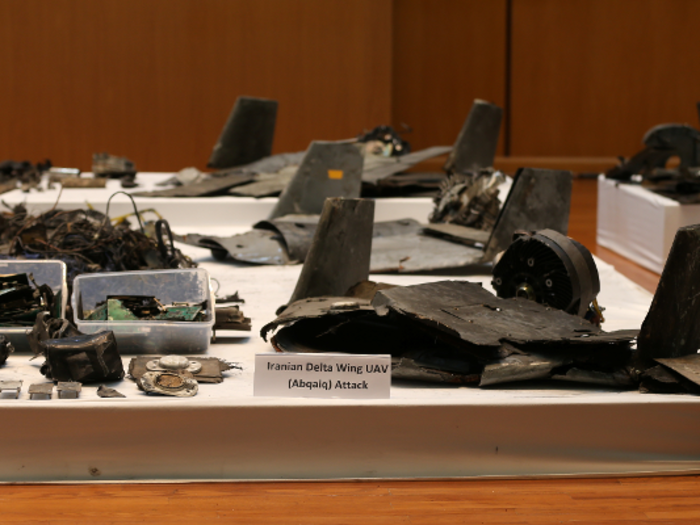
Houthi rebels in Yemen have claimed responsibility for the attack.
The Houthis are a Shia rebel group backed by Iran, which helped overthrow the Yemeni government in 2015. They have been fighting against Saudi-backed forces in Yemen for the past four years, causing the world's worst humanitarian crisis, according to the UN. The US has supported Saudi's campaign with intelligence and logistics, including US-made bombs.
Al-Malki stopped short of saying that the missiles were launched by the Iranian government, but says that the evidence affirms Iran's involvement.

Al Malki told reporters that 18 drones and seven missiles targeted the facilities. Three of the missiles, those headed for Abqaiq, he said, failed to reach their destination.
Both the US and Saudi Arabia have said that the weapons were not launched from Yemen, whose border is about 500 miles from the attack site. Al-Malki said on Wednesday that their range was approximately 435 miles, and played a video of what he alleged was a drone approaching from the direction of Iran, TIME reports.
Shortly after the attack, photos purporting to show wreckage of the missiles in the Saudi Arabian desert began circulating on social media.
Social media users alleged that the photos, as Fabian Hinz, a researcher at the James Martin Center for Nonproliferation Studies, writes on Arms Control Wonk appeared to be of an Iranian Soumar cruise missile, which is modeled after a Soviet-era KH-55 cruise missile. But Hinz's examination of the wreckage indicated that it was actually a Quds 1, a missile the Houthis claim to have developed.
Well well well... pic.twitter.com/bPgY6J67JE
— محمد بن خالد (@MbKS15) September 14, 2019
In Wednesday's news conference, al Malki said that the missiles were Ya Ali missiles — the same type of weapon that Saudi Arabia said was used in the attacks on Abha airport in June.
But as Hinz noted on Twitter, the wreckage al-Malki presented actually matches the components of a Quds 1, including the type of engine used — a Czech-designed TJ100.
However, Hinz notes, Iran appears to be manufacturing replicas of the TJ-100, too, for use in its drone program. Iran could potentially be furnishing a component, or an entire missile, for use by its Houthi proxies — or the appearance of such a use, Hinz claims.
So the missile debris presented today almost certainly belongs to Quds 1 cruise missiles. The engine matches the Quds 1's Czech-designed TJ-100 engine pretty well ( rear cover might have been changed on one of them) pic.twitter.com/ddxzwwNpCI
— Fabian Hinz (@fab_hinz) September 18, 2019rear fuselage matches pretty well too pic.twitter.com/AwbGpEoYMo
— Fabian Hinz (@fab_hinz) September 18, 2019
It could simply mean that Iran is manufacturing weapons components for its proxies. While Hinz notes that the Quds 1 hasn't been seen within Iran, other weapons seen in Yemen are composed of parts suspiciously similar to ones from Iran, pointing out specifically the Badr-1P precision-guided missile and the Badr-F precision-guided missile.
The Houthis are still claiming responsibility for the attacks on Saudi Aramco facilities, but as NPR points out, their claims don't actually match the numbers. Saria said that the Houthis launched 10 drones in the Aramco strike, but satellite images show 17 points of impact at the facilities.
Houthi military spokesman Yahya Saria said that they used Samad 3 and Qassef 3 drones, some equipped with bombs, to carry out the strike, and that they planned to strike the United Arab Emirates, a partner in the Saudi coalition fighting the Houthis which has greatly stepped back its involvement in the campaign.

The United States has been forceful in its assessment that Iran is behind the attacks, with Secretary of State Mike Pompeo calling the incident "an act of war" on Wednesday.
It's unclear how the US, which has been edging ever closer to direct conflict with Iran all summer, will respond to an attack on its ally Saudi Arabia. President Donald Trump seeks to increase sanctions on Iran, Bloomberg reports, but whether there will be a military response is unclear.
Shortly after the incident on Saturday, Trump tweeted that the US was "locked and loaded," seemingly threatening attack. Just a day later, he told reporters, "Do I want war? I don't want war with anybody."
 I spent $2,000 for 7 nights in a 179-square-foot room on one of the world's largest cruise ships. Take a look inside my cabin.
I spent $2,000 for 7 nights in a 179-square-foot room on one of the world's largest cruise ships. Take a look inside my cabin. Saudi Arabia wants China to help fund its struggling $500 billion Neom megaproject. Investors may not be too excited.
Saudi Arabia wants China to help fund its struggling $500 billion Neom megaproject. Investors may not be too excited. One of the world's only 5-star airlines seems to be considering asking business-class passengers to bring their own cutlery
One of the world's only 5-star airlines seems to be considering asking business-class passengers to bring their own cutlery From terrace to table: 8 Edible plants you can grow in your home
From terrace to table: 8 Edible plants you can grow in your home
 India fourth largest military spender globally in 2023: SIPRI report
India fourth largest military spender globally in 2023: SIPRI report
 New study forecasts high chance of record-breaking heat and humidity in India in the coming months
New study forecasts high chance of record-breaking heat and humidity in India in the coming months

Copyright © 2024. Times Internet Limited. All rights reserved.For reprint rights. Times Syndication Service.